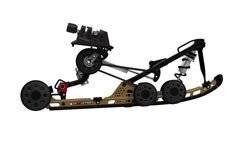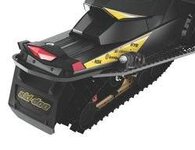Ski-Doo's engineers heard consumers' complaints about what a pain it is to make suspension adjustments out on the trail. They also targeted consumers wants of increased comfort, capabilty, capacity, and travel through the use of a progressive rear shock. While Ski-Doo has consistently upgraded the user-friendliness and motion ratios of their suspensions for years, moving from wrench and tool-only adjustability, and giving their sleds a bigger range of capability they had not gotten it totally right - until this year.
Last year we saw small knob adjusters that could be turned by hand and there was also more accessible tool adjustability. This year Ski-Doo introduces a total glove-friendly and easy-to-reach system, the new rMotion rear suspension, the culmination of Ski-Doo's last several years of suspension evolution. The new suspension claims to give better stutter and small bump performance and mroe ability to take on the absolutely largest bumps you can find. Steve Cowing (Ski-Doo's Media Relations and PR Manager) said, "The 'sweet spot' of this suspesion is broader and is created by separating the spring and shock motion ratios and giving the rear shock a rising rate. Something a coil over design will not be able to do. This suspension will give better transfer control. It will come on several sleds for 2012 and a couple of different configurations. More news on the full lineup soon.
The MXZ line will feature the rMotion as it replaces the very solid SC-5. Ski-Doo engineers again tell us one of the main advantages of rMotion is that the range of capability has been increased and rMotion is more comfortable over a larger array of trail conditions and terrain. rMotion has a progressive motion ratio throughout its stroke and when we studied the motion ratio graph of this rear shock compared with the SC-5 we noticed that rMotion does not mellow out at the end of a stroke, but stays progressive. Travel also is increased 2 inches from the SC-5 and engineers focused on keeping the suspension comfortable in small bumps. Yet it's also able to tackle the biggest, sharpest bumps in the trail. To reiterate, the inverted rear shock reduces unsprung weight too.
The top-of-the-line rMotion Quick-Adjust version comes on just the Spring Order MXZ X and X-RS models and such limited availability should be a big incentive to buy early.
What we appreciate most is the easy to use and large glove-friendly adjustment knobs on the top and rear of these sleds' running boards. These knobs adjust pre-load and compression damping with the knob on the left side massaging the torsion spring adjustability, or preload.
You can choose how you want it to behave - some with your right thumb - more with the larger range of transfer block adjustment, better cornering with the longer front arm, maintain a low center of gravity, maintains use of tunnel for cargo and has less unsprung weight moving around. Any weight moving with the suspension carries energy/momentum and you have to try and control that - rather than using your shocks and springs to control the rest of the sled."
So, instead of turning the sled on its side and hauling a wrench out of the tool bag to adjust the cam on the torsion springs, you simply have to turn a knob on the back of the boards. There is a hydraulic mechanism that then heightens or lowers the tension on the springs, just like the cam would. That's great, BUT adjustments now are over a 40% wider range too and are more customizable within that range. On the right side running board you'll find the compression damping adjuster, or clicker. Again a large easy to turn knob offers a wide range of adjustability.
This single knob damping adjuster controls both the high- and low-speed adjustments and they move together. The suspension also has two mounting points for the rear shock, which means two types of motion ratios and two separate ride experiences. The standard, or bottom mount, is more for a performance ride and the second mounting, or top, is for a more sport or softer ride.
In addition, the coupling blocks on all rMotion-equipped sleds have a button on them to aid in quick changes. Just press the red button on the block and rotate the blocks to your preferred coupling setting. Again, the upside is that this can be done with gloves on and without tools. If you get the standard rMotion rear suspension, the piggybacker on the inverted rear shock is still easy to get at to change compression damping and has a large easy-adjust knob as well. Watch for our Spring issue for more on this, the 2012 lineup and a first ride on an rMotion sled.






